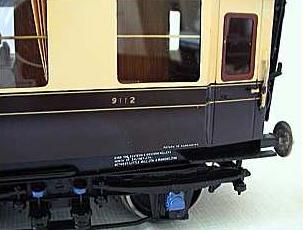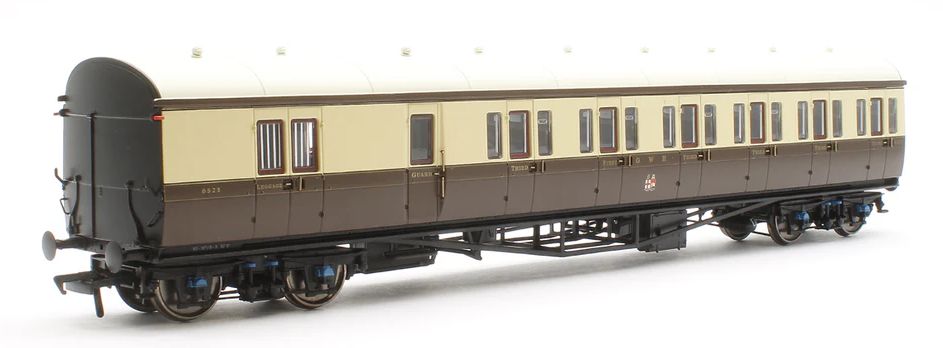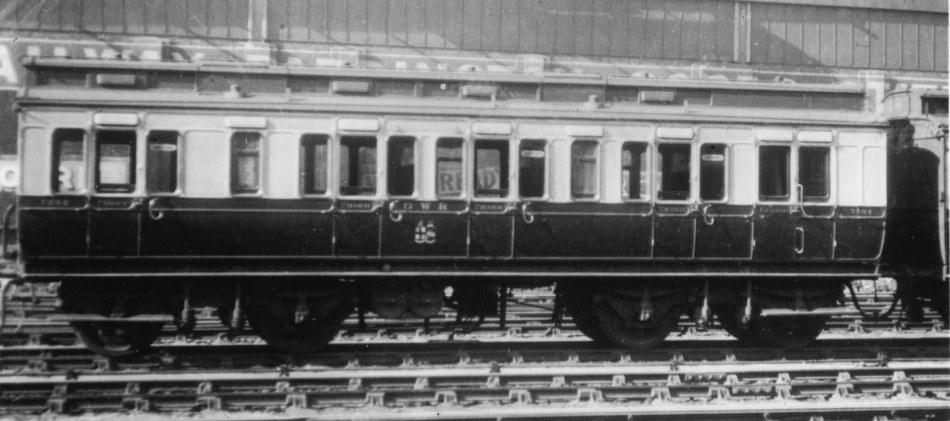GWR coach livery 1927–1934

Slaters D47 'Toplight' brake 3rd, picture courtesy of its owner, James Hilsdon
The 1927–1934 livery did away with the magnificent 'old world' lining schemes and introduced a new, modern finish.
The first step came in 1927, when a simple chocolate and cream livery was introduced. This was at first devoid of all lining, but soon afterwards a single yellow line was introduced to define the boundary between the chocolate and cream. The single line was soon changed from yellow to gold.
Initially, the garter crest contined to be applied, but in 1928, the new livery was consolidated with the introduction of the coat of arms, replacing the garter crest. 'G W R' lettering appeared at waist level, above the coat of arms.
From around 1929, the waist-lining was changed to gold and black lines. These were doubled for 'the best express stock', as in the adjacent photo of the Super Saloon, the lining panel having a black perimeter. The lines were 3/8" gold and 3/4" black. Ordinary stock however continued with just a single black and gold demarcation.
Droplights and bolections continued to be in mahogany colour.
The tops of axle boxes being painted blue began in 1927, but used only to indicate that the axle boxes had been modified.
From 1932 to 1937, 3rd class compartments were longer labelled 'Third'. Lettering remained on firsts and guards compartments. 'Third' markings were retained however for stock only with end doors, and workmen's stock in all-over unlined brown livery, where the 'Third' notation was applied in the waist panel, twice, located between compartments.
|

Collett 'Super Saloon' in Gauge 1, built by the Finescale Locomotive Company. Note oil-boxes in bright blue for identification. Image courtesy Keith Holman
|

Diagram E140 B-set by Rapido, in the livery this diagram first appeared in 1930. At the time, the B-sets were considered special, and warranting double lining at the waist. Image courtesy Rapido Trains.
| The simplified livery on a bow-ended Brake Composite diagram E129 of 1926, built from a 4mm Comet kit. Pairs of such coaches were attached end-to-end, typically for branch services, and in some operating divisions, this was known as a 'B-set'. Image courtesy Comet Models (now marketed by Wizard Models).
|

|

Diagram F12 ex-slip coach in 1928 livery

From the mid-1920s, some older Passenger Brake Vans began to be painted in all-over brown. Here is Tony Richards' 40' K29 (ex-K14) Passenger Luggage Van, running on 9' American bogies, and with the guard's side lookout removed and plated over. (There was little point in keeping such lookouts on narrow-bodied stock, given the width of most of the stock they were running with was 9' or more.) Tony's description of how he transformed this old Ks kit is given on the Swansea Railway Modellers Group site.
|